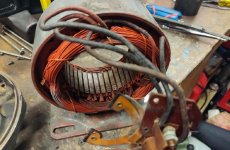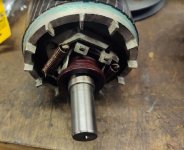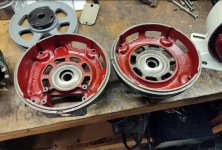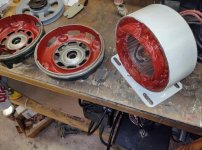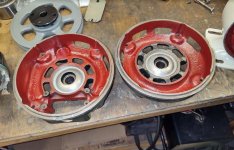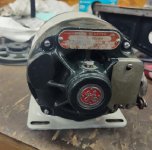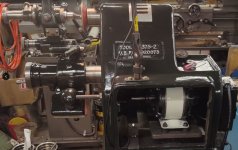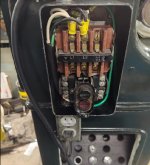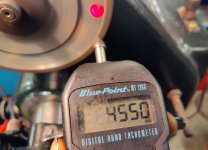texasgeartrain
Titanium
- Joined
- Feb 23, 2016
- Location
- Houston, TX
Back in post #15 I discussed belt and pulley sizes, and speeds. Moving on to do something about it.
Most 4" wheels are most efficient in the 5200 rpm range. The way this machine was set up as I got it, was 3200 rpm with a 6" wheel. For now my goal is to move back to the machine's more natural 4" wheels. I have acquired multiple different wheels and cutters. Most are rated at 5000rpm or higher. But I have one rated 4800 rpm, and a cutter a 4500 rpm, as I recall.
Eric had a good suggestion of using a 3 phase motor with a vfd so I could set speeds where ever I want. I also prefer 3 phase motors. But due to limited floor space, I will need to roll this machine into and out of my way. So I'm thinking a single phase cord will be easier to drag around. Plus I'm not quite as experienced as regular grinder guys to know the fine details of finishes with higher and lower speeds.
Somewhere I saw Buck mention multiple pulleys for speed changes. I think this may work for me. For now I plan on running the machine at 4500 rpm spindle speed until I'm comfortable. But I also have a 2nd spindle pulley to take me to 5050 rpm, should I decide to get more fancy.
My motor speed should be 1725. I'm using 3L belts. The pulleys available are deeper groove for 3L and 4L use. Using 3L belts will put my motor pulley at 5.86" OD:

To get the 4500 rpm at spindle, I'm using a 2.25" OD for 3L pulley at spindle:
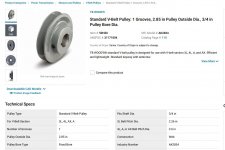
With those pulley OD's and motor speed at 1725 rpm, we can see my spindle speed should be 4500 rpm using the calculator:

That calculator is here:
 www.blocklayer.com
www.blocklayer.com
Most 4" wheels are most efficient in the 5200 rpm range. The way this machine was set up as I got it, was 3200 rpm with a 6" wheel. For now my goal is to move back to the machine's more natural 4" wheels. I have acquired multiple different wheels and cutters. Most are rated at 5000rpm or higher. But I have one rated 4800 rpm, and a cutter a 4500 rpm, as I recall.
Eric had a good suggestion of using a 3 phase motor with a vfd so I could set speeds where ever I want. I also prefer 3 phase motors. But due to limited floor space, I will need to roll this machine into and out of my way. So I'm thinking a single phase cord will be easier to drag around. Plus I'm not quite as experienced as regular grinder guys to know the fine details of finishes with higher and lower speeds.
Somewhere I saw Buck mention multiple pulleys for speed changes. I think this may work for me. For now I plan on running the machine at 4500 rpm spindle speed until I'm comfortable. But I also have a 2nd spindle pulley to take me to 5050 rpm, should I decide to get more fancy.

My motor speed should be 1725. I'm using 3L belts. The pulleys available are deeper groove for 3L and 4L use. Using 3L belts will put my motor pulley at 5.86" OD:

To get the 4500 rpm at spindle, I'm using a 2.25" OD for 3L pulley at spindle:

With those pulley OD's and motor speed at 1725 rpm, we can see my spindle speed should be 4500 rpm using the calculator:

That calculator is here:
Pulleys and Belts - Inch
Visually calculate pulley size rpm belt length and speed wwith animated scaled diagrams - Inch
Last edited:









